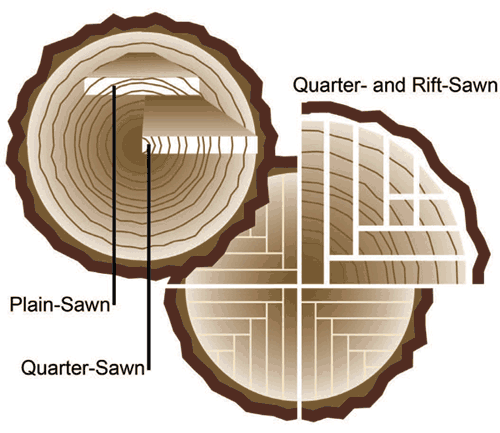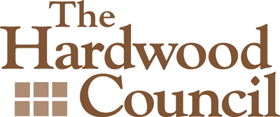The American Hardwood Advantage: Carbon-neutral Materials for Today's Zero Tolerance Goals
In yet another study, the Athena Model, developed by the non-profit Athena Sustainable Materials Institute, compares the cradle-to-grave ecological quotient of wood, steel and concrete across the six stages of a material's life expectancy: resource extraction, manufacturing, on-site construction, facility occupancy, demolition and ultimate reuse or recycling. The Athena Model found wood to have the lowest environmental impact in each of these categories, and that wood exceeds the other materials in terms of environmental soundness; energy use; production of greenhouse gases; air and water pollution; production of solid waste; and overall ecological resource use.
"The more people learn about the environmental credentials of American hardwood - throughout its life cycle - the clearer it becomes that wood has important environmental advantages over almost every other material. Wood is not only recyclable and renewable, but also uses much less energy in its manufacturing process and creates much less waste than materials such as concrete, steel, aluminium or plastics," says Mike Snow, Executive Director of the American Hardwood Export Council.
Green Points - A Changing Landscape
Besides the USGBC's LEED rating systems for green construction, points have been created by a number of entities, including the NAHB (National Association of Home Builders), which rewards the use of any bio-based material, notably wood and recycled materials, such as reclaimed flooring. For commercial projects, there is also Green Globes certification, which is coordinated by the Green Building Initiative and features an online assessment protocol, and guidance for green building design, operation and management.
When seeking points for the use of wood, these current rating systems rely on one of the certification systems currently in place to verify that the wood comes from a sustainably managed forest - the Forest Stewardship Council (FSC), which is the most well-known certification program, international in scope and with the backing of most environmental groups. The program tracks wood from the forest to the end product.
Something else that sets the United States apart from most countries in the world is the predominance of private ownership. Around 73 percent of hardwood forest land in the United States is privately owned, often by families whose ownership stretches back several generations. There are approximately 11 million private forest owners with an average lot size of 20 hectares. It is usual for a sale of hardwood logs to occur only once, perhaps twice, in any landowners' lifetime. Timber sales are a low percentage of lifetime expected income for these owners, so even a significant increase in timber value (which at present does not occur with certification) provides no real incentive for owners to achieve certification. The lumber that an American hardwood mill supplies to its customers will come from thousands of landowners-and next year it will be an entirely different group.
The USGBC is in the process of re-thinking its stance on certification. In July of 2008 the USGBC requested public comment on revisions to the language in its LEED rating system related to LEED requirements for wood certification programs. "The proposed evolution of the certified wood credit in LEED will help focus the forest certification conversation on outcomes and performance," said Brendan Owens, vice president of LEED technical development for USGBC. As of this writing, LEED points are only awarded to wood products certified by FSC. Any change made by USGBC to the LEED requirements regarding certified wood may have substantial bearing on architects specifying hardwood from forests in private ownership. If they occur, these changes may provide specifiers with a wider range of choices.
With independent research affirming the carbon neutrality of woods, and rating systems expanding their certification of more and more forests, designers can be confident that when they specify American hardwoods, they are selecting a quintessentially green material in abundant and self-renewing supply. As the industry works toward the goal of carbon neutral buildings by 2030, American hardwoods will play an important part in how that goal is attained.
Hardwood Selection |
Unlike factory-made, artificial materials, each hardwood board has a unique life story. During the approximately 60 years it takes for a hardwood to mature, each tree develops a one-of-a-kind grain pattern and texture. Hardwoods are shaped by natural forces and they may display a variety of character markings. Even boards from the same hardwood tree will show significant variation in color. For instance, "younger" wood closer to the bark (sapwood) will be lighter than that which comes from the central portion (heartwood). Also visible are the effects of the minerals and other essential elements that the tree absorbed as it grew. The following terms are important to know:
Quarter-sawing is a slower and thus more expensive process than flat-sawing. The log actually is cut into quarters and sawn quarter by quarter. A single board is sawn from one face, then the next board is sawn from the opposite face and the sawing proceeds on alternate faces. In quarter-sawn lumber, the growth rings are perpendicular to the board's broad face, producing a vertical and uniform grain pattern. This method yields fewer and narrower boards per log than flat-sawing, boosting their cost significantly. The growth rings in rift-sawn lumber are at 30 to 60 degree angles to the board surface, producing vertical graining that is easily confused with quarter-sawn. Rift-sawn lumber also is available in limited quantities. All lumber processing produces some quarter-sawn and some rift-sawn lumber. However, at least 95 percent of all hardwood lumber commercially produced in the U.S. is flat-sawn. Sustainable design recognizes that no sawing method is superior and that all hardwood products will expand and contract as they reach balance with the relative humidity of their surroundings. The type of cut creates the look of finished board or trim. By specifying efficient board cuts, or knots, or other character marks in the wood, well-informed, green-thinking architects have the potential to influence the manufacturing process of sustainable wood products.
|
Compared to the other methods, flat-sawing produces the most lumber and the widest lumber at the least cost. Quarter-sawing is a slower and more expensive process. |
Â
Â
|










